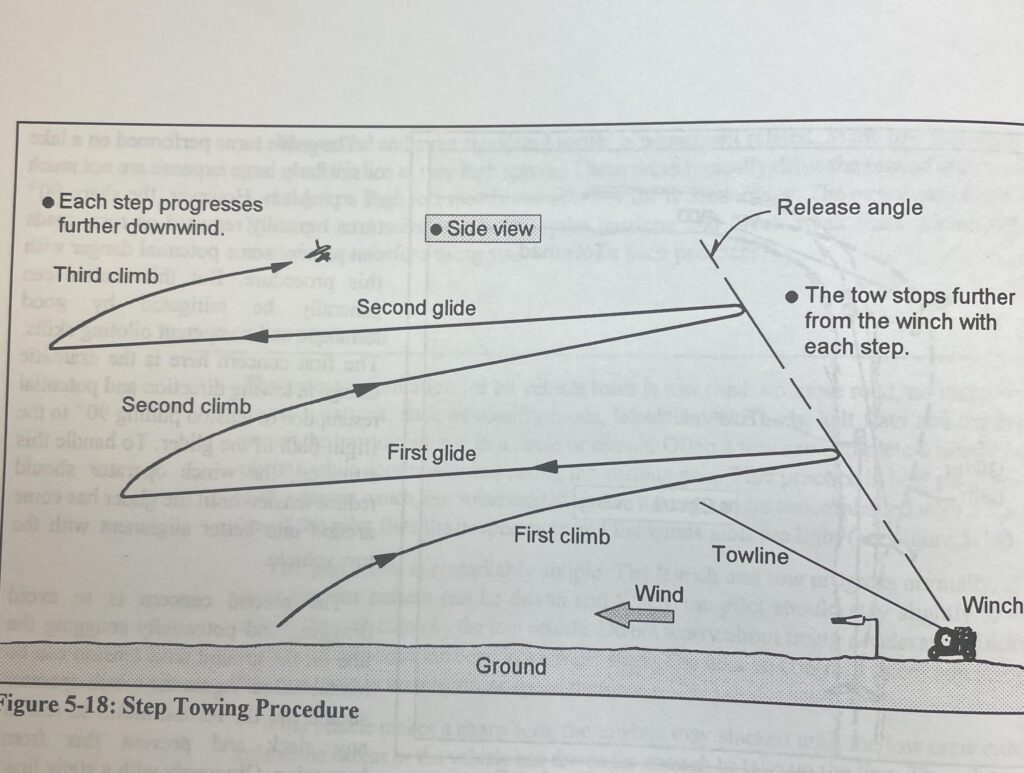The Step Tow Method
Here is a description of the method: Once the glider has reached the end of the tow, tensions are dropped and the glider turns downwind and pulls the towline behind it. After flying above the original launch point or beyond, the glider turns back into the wind. Tow tensions are reapplied and the glider is pulled again to climb higher. The glider’s altitude ratchets up in sequential steps with each cycle as shown in figure 5-18.
Since the climb rate on a winch tow slows down the closer you get to the winch, the second climb should stop short of the winch. Each subsequent climb should stop shorter still, and continue further downwind, even past the limits of the field (if safe clearance is maintained) as the figure shows.
This procedure will get you the highest in the shortest length of time. Also, if the winch is equipped with a universal payout head that allows it to tow with the line in any direction, you should fly directly downwind after the first tow so all subsequent reel-ins are headed directly upwind for maximum climb rate.
Step towing should not be practiced by inexperienced tow pilots. A very careful turn, from the downwind leg back upwind is required to prevent looping the towline over the wing of the hang glider. If a paraglider pilot turns the wrong way, he or she will become wrapped in the towline.
With a tow line 1,500 m long, and take off field 500-700 m, here is the procedure:
Step 1. Tow up to 300 m, turn down wind glide to 200m
Step 2. Turn up wind, tow up to 400 m, turn down wind glide to 200m.
Step 3. Turn up wind, tow up to 600 m, turn down wind glide to 400 m.
Step 4. Turn up wind, tow up to cable limit to max 45% slant angle from winch.
This procedures can be best achieved by a remote controlled-self towing e-winch.
step Towing Equipment
Communication and coordination between the winch operator and pilot are extremely critical for the preservation of safety. We believe reliable radios are an absolute requirement for step towing. When the pilot turns back upwind, the glider is generally much too distant for visual inspection of the line by the winch operator. A glider pointed back towards the winch does not indicate a safe condition to resume towing. A radio transmission from the pilot is required to confirm that.
The second piece of equipment required for step towing is the correct bridle and release system. Any hang glider bridle connection over the control bar or attached to the keel is unequivocally unacceptable when the glider turns and runs downwind. Such arrangements could cause a hang glider to dive if some tension develops in the line during the downwind leg. The towline must only connect to the pilot below the control bar. The Skyting bridle and V bridle obviously may not be used. A single point connection to the pilot is required. The typical bridle used for platform launch towing may be used. Launches must be from a platform or dolly since these bridle configurations do not readily accommodate foot launching. As an alternative, the two-stage release system which allows release of the top line may be utilized. With such an arrangement the pilot may foot launch and once well into the air, release the first stage and continue being towed by the second line under the control bar.
Caution: By the time the glider is ready to turn around for the first time, no part of the bridle should be attached above the base tube (to either pilot or glider) so the control bar is not pulled backwards when the towline is behind the pilot.
Paraglider bridles must be attached and releases routed so that wrapping the line half way around the pilot’s body or between the pilot’s legs does not initiate a premature release or entangle them with the harness or ancillary equipment. Furthermore, reliable activation ofthe release must still be possible when in that position.
Step Tow Procedures—stationary Winch
With the stationary winch, when the pilot has reached the end of the tow, he commands “drop tension” rather than releasing. The winch operator should drop the tension immediately. A few pounds (l or 2 kg) of tension or drag are desirable to prevent freewheeling of the drum and spinning off excess line. It also serves to keep the line off the ground to minimize snagging. Radio back, “drop tension confirmed. ” The pilot now knows he can safely turn 180 degrees and head downwind trailing the line. This phase of the tow is critical. The line must be dispensed smoothly with no jerks or snags. A superior level-wind system is essential for obtaining the tight clean wraps required for this activity.
The pilot must not get too low before turning back into the wind nor tow the line over any obstacle that could snag the line. If winds are significant, do not forget to account for drift and begin a turn early.
A hang glider pilot must be especially careful when making the winch. If the pilot rolls too aggressively while making the turn, the wing will pass below the towline and loop it over the wing (see figure 5-19). This is a very precarious situation which will be dealt with in Emergency Procedures (Line Snags) later in this chapter. Keep the turn very shallow. The towline must be kept in sight during the whole turn. If you lose sight of it, promptly level out and reestablish its position.
The paraglider pilot must make a decision when turning downwind. When the turn away from the winch is made, the line can be routed around his side and back to the winch, or he can lift a leg over the line and pull it back between his legs. The seat of the harness generally prevents any crotch discomfort from the line. When turning back towards the winch to resume the tow, if the line is wrapped by his side, the pilot must turn in the opposite direction of the previous turn. In other words, if he turned right to head downwind, he must turn left to turn back upwind. Otherwise, the line will wrap completely around him. If the line routes between his legs, he must lift his inside leg way up to clear the line. This action can interfere with weight shift control of the paraglider. Because of the risk of not getting a leg up and over the line and compromise to the weight, we suggest pulling the line by your side.
When the glider is oriented back into the wind and aligned with the winch, radio “resume tension”. The winch operator should smoothly reapply tension.
Step Tow procedures—payout winch
The step tow with the payout is similar to the above, except the tow crew has some added tasks. When the pilot commands, “drop tension,” the winch operator should turn the tension’ down to nothing but periodically bump the switch controlling the rewind system to maintain a few pounds of tension and take up any slack. Radio back to the pilot, “drop tension confirmed. ” The driver should perform a U-turn and begin driving in the opposite direction. If winds are light, the vehicle can accelerate out in front of the glider and the tow resume in the opposite direction. However, in very strong it usually is not worth the effort and the vehicle will need to be traveling at 50 to 60 mph (80 to 100 lannl) or more. Rather, follow the vehicle and when you reach the downwind end of the runway, both turn 180 0 for a subsequent tow. the glider has completed his turn and the tow vehicle is in position, the pilot should radio, “resume tension. ” The winch operator should insure the line did not snag or catch on the vehicle during the turn and then smoothly increase the braking force on the drum. The driver should accelerate to the appropriate vehicle speed for the tow.
Some pilots use the terms “all out” or “clear” for the resumption of tension. We are not particularly keen on those signals since occasionally there may be other towing operations in the area. If the tow crew overhears a transmission from another team, it could be particularly hazardous for the pilot.

